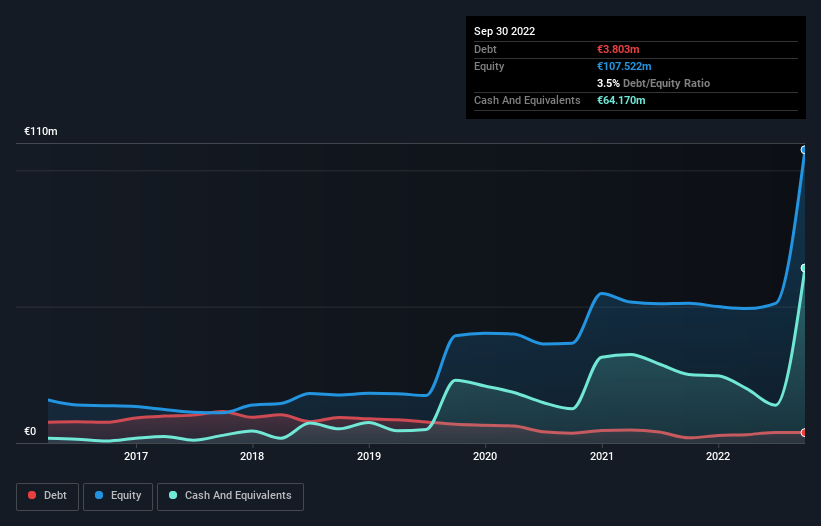Legendary fund manager Li Lu (who Charlie Munger backed) once said, 'The biggest investment risk is not the volatility of prices, but whether you will suffer a permanent loss of capital.' So it might be obvious that you need to consider debt, when you think about how risky any given stock is, because too much debt can sink a company. As with many other companies SFC Energy AG (ETR:F3C) makes use of debt. But the more important question is: how much risk is that debt creating?
What Risk Does Debt Bring?
Debt is a tool to help businesses grow, but if a business is incapable of paying off its lenders, then it exists at their mercy. Part and parcel of capitalism is the process of 'creative destruction' where failed businesses are mercilessly liquidated by their bankers. While that is not too common, we often do see indebted companies permanently diluting shareholders because lenders force them to raise capital at a distressed price. By replacing dilution, though, debt can be an extremely good tool for businesses that need capital to invest in growth at high rates of return. The first thing to do when considering how much debt a business uses is to look at its cash and debt together.
View our latest analysis for SFC Energy
What Is SFC Energy's Net Debt?
The image below, which you can click on for greater detail, shows that at September 2022 SFC Energy had debt of €3.80m, up from €1.89m in one year. But it also has €64.2m in cash to offset that, meaning it has €60.4m net cash.

How Healthy Is SFC Energy's Balance Sheet?
The latest balance sheet data shows that SFC Energy had liabilities of €26.4m due within a year, and liabilities of €11.9m falling due after that. Offsetting this, it had €64.2m in cash and €22.7m in receivables that were due within 12 months. So it can boast €48.5m more liquid assets than total liabilities.
This surplus suggests that SFC Energy has a conservative balance sheet, and could probably eliminate its debt without much difficulty. Succinctly put, SFC Energy boasts net cash, so it's fair to say it does not have a heavy debt load!
We saw SFC Energy grow its EBIT by 6.5% in the last twelve months. That's far from incredible but it is a good thing, when it comes to paying off debt. The balance sheet is clearly the area to focus on when you are analysing debt. But ultimately the future profitability of the business will decide if SFC Energy can strengthen its balance sheet over time. So if you want to see what the professionals think, you might find this free report on analyst profit forecasts to be interesting.
Finally, a business needs free cash flow to pay off debt; accounting profits just don't cut it. SFC Energy may have net cash on the balance sheet, but it is still interesting to look at how well the business converts its earnings before interest and tax (EBIT) to free cash flow, because that will influence both its need for, and its capacity to manage debt. Over the last three years, SFC Energy saw substantial negative free cash flow, in total. While that may be a result of expenditure for growth, it does make the debt far more risky.
Summing Up
While we empathize with investors who find debt concerning, you should keep in mind that SFC Energy has net cash of €60.4m, as well as more liquid assets than liabilities. On top of that, it increased its EBIT by 6.5% in the last twelve months. So we are not troubled with SFC Energy's debt use. When analysing debt levels, the balance sheet is the obvious place to start. However, not all investment risk resides within the balance sheet - far from it. For example SFC Energy has 3 warning signs (and 1 which makes us a bit uncomfortable) we think you should know about.
At the end of the day, it's often better to focus on companies that are free from net debt. You can access our special list of such companies (all with a track record of profit growth). It's free.
New: Manage All Your Stock Portfolios in One Place
We've created the ultimate portfolio companion for stock investors, and it's free.
• Connect an unlimited number of Portfolios and see your total in one currency
• Be alerted to new Warning Signs or Risks via email or mobile
• Track the Fair Value of your stocks
Have feedback on this article? Concerned about the content? Get in touch with us directly. Alternatively, email editorial-team (at) simplywallst.com.
This article by Simply Wall St is general in nature. We provide commentary based on historical data and analyst forecasts only using an unbiased methodology and our articles are not intended to be financial advice. It does not constitute a recommendation to buy or sell any stock, and does not take account of your objectives, or your financial situation. We aim to bring you long-term focused analysis driven by fundamental data. Note that our analysis may not factor in the latest price-sensitive company announcements or qualitative material. Simply Wall St has no position in any stocks mentioned.
About XTRA:F3C
SFC Energy
Develops, produces, and distributes systems and solutions for stationary and mobile off-grid power supply based on hydrogen and direct methanol fuel cells worldwide.
Excellent balance sheet with reasonable growth potential.
Similar Companies
Market Insights
Community Narratives



